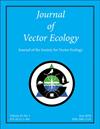墨西哥东南部尤卡坦地区局部皮肤利什曼病新发现的白蛉沙蝇(双翅目:沙蝇科)
IF 1.3
3区 农林科学
Q2 ENTOMOLOGY
引用次数: 6
摘要
摘要:局部皮肤利什曼病(LCL)是尤卡坦半岛的地方病,历史和现代记录主要在坎佩切州和金塔纳罗奥州。最近,我们在尤卡坦州天宁市报告了本地LCL病例和27.6%的无症状感染者,该市尚未对Phlebotominae(直翅目:Psychodidae)沙蝇进行研究。在这项工作中,从2019年11月到2020年2月,我们在天宁岛的三个地区进行了一项实地研究,首次记录了有人类利什曼病传播记录的地区的Phlebotominae物种。按丰度顺序,已鉴定的物种为细粉菌、山诺尼粉菌、克拉氏粉菌、十字斑菌、olmeca olmeca双色菌和deleoni Dampfomyia。大多数沙蝇是在香农陷阱中捕获的,在那里收集的标本中77.8%是雌性。沙蝇物种的分布在不同地点之间表现出一定程度的异质性,物种丰富度最高的地点位于Xcalakoop。我们还讨论了鲁、山诺尼和皮在医学上的重要性。serrana是该地区LCL致病因素的潜在载体。本文章由计算机程序翻译,如有差异,请以英文原文为准。
Phlebotomine sand flies (Diptera: Psychodidae) from an emergent focus of localized cutaneous leishmaniasis in Yucatan, Southeast Mexico
ABSTRACT: Localized cutaneous leishmaniasis (LCL) is endemic in the Yucatan Peninsula, with historical and contemporary records mainly in the states of Campeche and Quintana Roo. Recently, we reported autochthonous LCL cases and 27.6% of asymptomatic infection in the municipality of Tinum, Yucatan, where no studies of Phlebotominae (Diptera: Psychodidae) sand flies have been carried out. In this work, from November, 2019 to February, 2020, we conducted a field study in three areas of Tinum to document, for the first time, the species of Phlebotominae in areas with records of human leishmaniasis transmission. In order of abundance, the species identified were Pifanomyia serrana, Psathyromyia shannoni, Psathyromyia cratifer, Lutzomyia cruciata, Bichromomyia olmeca olmeca, and Dampfomyia deleoni. Most of the sand flies were captured in a Shannon trap where 77.8% of collected specimens were females. The distribution of sand fly species showed some degree of heterogeneity among sites, and the highest species richness was registered in a site located in Xcalakoop. We also discuss the medical importance of Lu. cruciata, Ps. shannoni, and Pi. serrana as potential vectors of causal agents of LCL in this area.
求助全文
通过发布文献求助,成功后即可免费获取论文全文。
去求助
来源期刊

Journal of Vector Ecology
生物-昆虫学
CiteScore
2.60
自引率
5.90%
发文量
31
审稿时长
6-12 weeks
期刊介绍:
The Journal of Vector Ecology is an international journal published by the Society for Vector Ecology. It is concerned with all aspects of the biology, ecology, and control of arthropod and vertebrate vectors and the interrelationships between the vectors and the agents of disease that they transmit. The journal publishes original research articles and scientific notes, as well as comprehensive reviews of vector biology based on presentations at Society meetings. All papers are reviewed by at least two qualified scientists who recommend their suitability for publication. Acceptance of manuscripts is based on their scientific merit and is the final decision of the editor, but these decisions may be appealed to the editorial board. The journal began publishing in 1974 and now publishes on-line only.
 求助内容:
求助内容: 应助结果提醒方式:
应助结果提醒方式:


